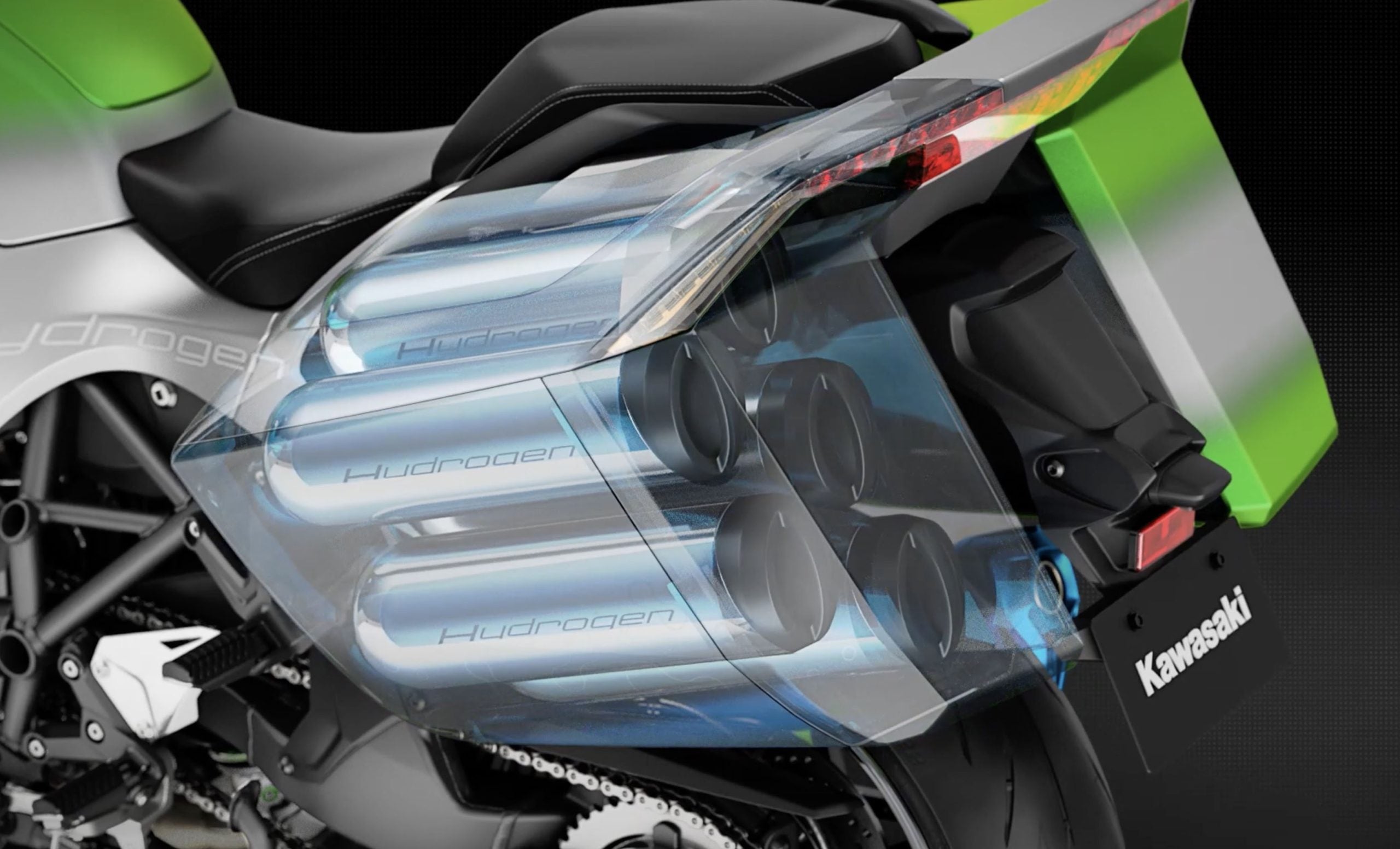Kawasaki unveiled three alternatives to regular combustion engine motorcycles at EICMA on Tuesday, including a prototype that runs on hydrogen. The new models (and hydrogen prototype) are part of Kawasaki’s “Go WIth Green Power” initiative that the company is hoping will help them achieve carbon-neutral status by 2030. A fine goal, but besides the new-think high-tech bikes, Kawasaki also said they would have 30-odd models that use traditional internal combustion gas engines in the 2023 lineup as well. Seven years and counting, Kawasaki.

The “Z” EV bike, the hybrid and the hydrogen concept bike. Image: Kawasaki
Here’s a bit of a closer look at the trio of new electric models, although Kawasaki has released few technical details about any of these models beyond saying that the EV and hybrid bikes will see production. “These are prototypes of actual motorcycles we will produce,” Masaya Tsuruno, Managing Director of Kawasaki Motors Europe, said at the Milan show.
All-electric EV and Z Street Models

The EV Ninja (maybe). Image: Kawasaki
Leveraging their history of “Z” (or “Zed”) models—for which 2022 is the 50th anniversary of the 1972 introduction of the original “Z”900—Kawasaki says they will put two all-electric machines into production in 2023, with the unusual hybrid coming in 2024.
One pure EV (photo above) model looks a lot like the current Ninja 250/300/400 models but houses an electric motor and removable—as in swappable—battery. Another is a more street-fighter style EV (below) with a trellis frame and minimal bodywork. Neither were really given specific model names beyond “EV” at the EICMA reveal.

Image: Kawasaki
Since the battery is only 3 kWh in size, this is definitely a short-distance, lower-powered bike destined for city use. No power, speed or performance numbers were mentioned. We feel these two models are unlikely to come stateside but could become available in the EU since they have a more robust charging infrastructure that could be about to see a significant change: battery swap stations.
Battery swap tech is now prevalent in Asian countries where scooter ownership is as common as car use in the U.S. and it makes sense: riders can swap out dying battery packs for a freshie in seconds using their phones and the cost is minimal, essentially giving their e-scooters unlimited range, at least in cities. Given the love for vending machines in most of Asia, it won’t be long until the swap stations spread into rural areas to allow longer – distance travel. Taiwanese firm Gogoro helped kick off the swap tech years ago; now mighty Honda is on board as well. If this tech becomes standardized (even to a few different battery types, not just one), it could revolutionize EV use in Asia, and Kawasaki is likely watching very closely or even planning their own swap system for bigger motorcycle batteries. Watch this space to be sure.
Hybrid “HEV” Sport Bike

The Kawasaki HEV Hybrid. Image: Kawasaki
The next bike Kawasaki revealed and said would go into production is a unicorn of sorts: A hybrid gas/electric motorcycle (above) so far just called “HEV” or “Hybrid.” This machine will house a gas engine, battery and electric motor that’s been snugged up to the gas engine, giving riders the best of both worlds: Worry-free gas engine distance riding capability along with zero-emissions urban capability.

Image: Kawasaki
And judging by the handlebar buttons, it looks like some video-game style e-boost will also be in the mix. Again, no specifics on engine size, battery size, range and electric motor power were specified, but Kawi says it’s going to hit showrooms in 2024. Game changer? Could be if it’s light enough, fast enough and affordable.
Style-wise, the Hybrid looks a little ungainly at this point, with a quite long wheelbase and funky-fitting bodywork that seems like a mashup of the H2 SX with some additional cladding. It’s likely going to be expensive (but think of all the gas money you’ll save riding in pure EV mode) and… complicated, but Kawasaki has been dinking away at this project for a long time now, so maybe they’ve got it really dialed in. We shall see.
Hydrogen-powered prototype

The hydro gas goes into back of the bike. Surely no handling penalty for that. Image: Kawasaki
The third model Kawasaki revealed is a pure concept bike, based on the popular Ninja 1000 SX tourer, except it runs on hydrogen. And no, we don’t mean a hydrogen-fed fuel cell making electricity; this bike will actually burn hydrogen gas in an internal combustion engine, and a supercharged one at that. How much power? Kawasaki did not say, so we’ll assume “a lot” if it ever comes to fruition.
Neat idea (and one that may have a future—someday) but for now, there are all kinds of problems with hydrogen ICE technology. First of all, you have to carry a lot of compressed hydrogen gas on the bike, which Kawasaki shows will be stored in cylinders (maybe swappable?) in the bike’s panniers area (below) where riders usually store their undies and such. So, goodbye carrying capacity.

Whatchya got in that pannier? A whole lotta compressed hydrogen. Image: Kawasaki
Second, you have to get hydrogen somewhere, and right now that means only California in the U.S., where there are several dozen stations servicing the fair number of hydrogen fuel-cell cars in that state. Beyond that, there are four stations in Canada (three in B.C. alone), and one in France, according to this fuel station tracking site.
That’s not much infrastructure compared to gas and electricity, and while I get the appeal of readily available and clean-burning hydrogen, the costs to make it, store it, transport it and then use it remains high, especially compared to electricity – or even gasoline, at this point. Does it have a future? Maybe, but using it in a motorcycle seems a real stretch, and I think Kawasaki will eventually let this dream quietly die as the barriers to scale became harshly apparent while pure electric and hybrid cars (and motorbikes and scooters) proliferate.
Check out the full reveal videos and shorter overview vid from Kawasaki below.
What do you think of the Kawi electrics? Leave a comment below the videos.
Skip to 19:35 for the EICMA presentation:
90-second overview:







